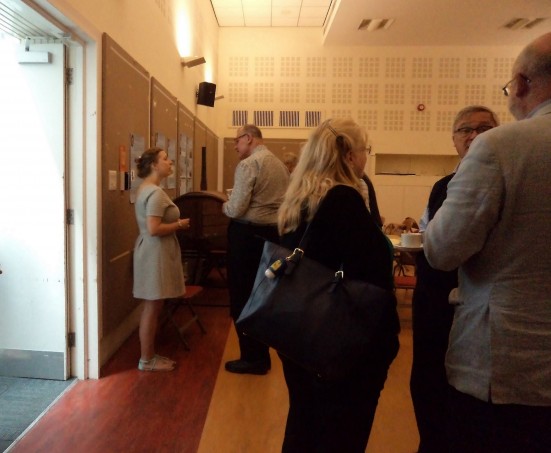Before I come to ‘Maritime Kent though the Ages’ this weekend and the great array of speakers, I thought I would very briefly mention that I attended two of the sessions last Saturday of the University of Kent’s Medieval and Early Modern Studies Summer Festival that featured six speakers from Canterbury Christ Church University.
The first panel that I attended on ‘Medieval English Royal Life’ featured Charlotte Liebelt, who is working on that fascinating Middle English poem ‘Havelok the Dane’. Written around 1300 it is a complex text that seems to have been speaking to contemporary events about kingship, but also other issues such as post Conquest resistance to Norman overlordship, and a deep-rooted concern to protect a personified England. Keeping with this sense of what constituted good kingship and the duty to protect the realm of England, Lily Hawker-Yates gave us the intriguing poem about King Harold’s burial beneath a mound overlooking the Hastings’ cliff, which was ordered by William the Conqueror following the battle of Hastings. However, in this case this is not about Harold’s duty in death as the protector of the realm, but rather William’s desire to demonstrate his domination over his Anglo-Saxon foe. In other words, the desire to grind Harold – literally – into the ground where he will become William’s ‘servant’ as protector of England. Finally, Abby Armstrong drew attention to the apparently loving father-daughter relationship between Henry II and his daughter Beatrice, who married into the ducal family of Brittany. Even though such a relationship might be expected, Abby explained that many historians have pointed to perceived emotional distances within the royal family, but that she believes the few surviving letters point to a much more loving relationship and that kings were sometimes seemingly prepared to put familial relationships before matters of state.
The second Christ Church panel featured Dr Claire Bartram, one of her postgraduates and another postgraduate who is also working on early modern letters. Robert Gill is looking at the campaign letters of Horace Ware, 1st Baron Tilbury. His letters are full on matters relating to managing a large army, whether that is provisioning, paying wages or ways of fighting. These letters also provide insights into rivalries among these very senior figures and tensions at the very top of Stuart society.
Claire Bartram concentrated on scribal production, especially ideas about patronage and clientelism, and the web of people among the Kentish Protestant nobility who had shared interests that they expressed through material culture – items offer tantalizing clues but recapturing earlier historical relationships is often extremely difficult. Keeping with this idea of writing and material culture Anthony Heathfield introduced us to professional and personal letter books, in particular the problems historians face when trying to investigate the latter. Anthony is working on Gabriel Harvey’s letter books with Claire Bartram, and it was very interesting to hear how he seeking to tackle such methodological questions.
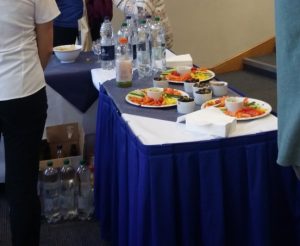
The wine reception provided by the Dean of Arts and Humanities (photo: Diane Heath)
So to this weekend and the Maritime Kent conference that started with Richard Holdsworth’s (Chatham Historic Dockyard) lecture on the pivotal role played by Kent in the defence of Britain for much of the last thousand years or so, and the Royal Navy’s importance since Tudor times. However, before I get to his talk, I want to thank the former Dean of the Faculty of Arts and Humanities Dr Keith McLay who very generously sponsored the wine reception before Friday night’s lecture before he left to take up a senior managerial post at the University of Derby. And at the same time, I would like to thank the Hospitality staff for doing such a great job over both day, everyone was very appreciative. Now, I don’t have space to provide a full report of Richard’s talk any more than I can for the further seven fascinating lectures that took place on Saturday. This means I’ll confine my report to a couple of points per speaker and you will either have to wait for the book on ‘Maritime Kent through the Ages’ – our ultimate goal; or search out articles by these various speakers.
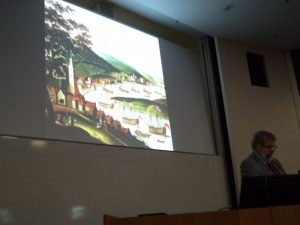
Richard Holdsworth discusses the early development of Chatham as a royal dockyard.
To return to Richard, he mentioned Kent’s role in national defence from Anglo-Saxon times, but his focus was on the Tudor period onwards, especially the key role Chatham and surrounding areas played as the place where scores of naval ships were constructed, the first being The Marlyon in 1579. Not that everything was always plain sailing over succeeding centuries – mid 17th-century corruption and the Dutch raid on the Medway in 1667 to name but two serious problems. Yet in the aftermath of this raid Chatham benefitted, not least because the Royal Navy was focused on home defence and the desire to control the North Sea and English Channel. Even when attention switched to the Navy’s global role, especially conflicts against French and Spanish forces in the Americas, and the consequent rise of Portsmouth and Plymouth, Chatham remained important for ship building and ship repairs. Moreover the 19th century brought organisational changes as this work moved from making to manufacturing, mechanisation (steam power) and the move to iron and steel, as well its proximity to London that provided renewed impetus for those in control at Chatham. Yet the coming of the Dreadnoughts finished this after 1906, and Chatham had to in a sense reinvent itself once again. However, these better times did not last, and the post-WWII climate was not good for the dockyard, albeit it has now reinvented itself once more as a brilliant heritage attraction that is part of a regeneration project for the Medway towns more broadly.
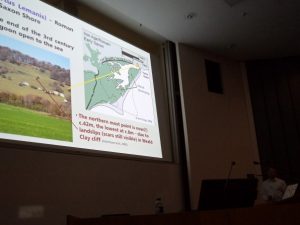
Chris Young discusses the markedly different landscape in late Roman times.
This was an excellent introduction to Maritime Kent, as seen by the number of questions from the audience afterwards, and this great start was continued when an audience of over seventy people gathered on Saturday morning to hear Dr Christopher Young’s (CCCU) fascinating examination of Kent changing coastal landscape starting around 450,000 years ago during periods of glaciation. As Chris explained, it is important to look at how such factors affected the underlying geology, especially regarding the chalk, the London clays and the southern clays and gravels by investigating the interplay between erosion and deposition. Chris’ exploration was exemplary of this complex and changing picture that geomorphologists are still seeking to understand fully. Here I’m just going to note the point that he made about relying on measured rates of cliff retreat from post the Little Ice Age rather than thinking about the implications of colder and wetter conditions – erosion due to fissures at the top not the bottom of cliffs, as well as the need to take more account of great storm events that seem to have been more frequent than is usually appreciated. And I’ll leave you with his final slide of a cartoon Cnut who perfectly understood that he could not hold back the tide – something we are inclined to forget in our obsession to protect the coastline at almost any cost.
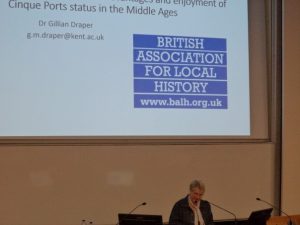
Gill Draper considers communities in the Cinque Ports.
The second session after coffee on ‘coastal communities’ commenced with Dr Gillian Draper’s (BALH) assessment of the privileged status of the Cinque Ports, including the two Ancient Towns of Rye and Winchelsea, and what this meant to both communities and individuals living in these Ports. Having outlined the relationship between the king and the Ports collectively, including the various advantages wives and daughters of freemen enjoyed in terms of property holding, she introduced the audience to two individuals who had benefitted considerably from being Cinque Portsmen: John Philipot of Grange, Grange being a limb of Hastings, and Adam Oxenbridge who had similarly taken full advantage of his and his family’s Cinque Port status as a man of Rye.
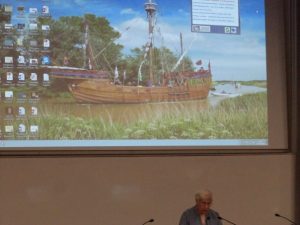
Gill Wyatt explores migration in Elizabethan Thanet.
Gill Wyatt also concentrated on the idea of family and the individuals involved in her investigation of the degree or otherwise of isolation involving the people of Elizabethan Thanet. Drawing on her research at the University of Kent and subsequent publication in Archaeologia Cantiana, Gill looked at migration through the lens of the parish registers, probate materials and church court depositions. These have revealed the presence of migrants from Flanders, Venice and Portugal, many probably religious refugees, but economic migration cannot be discounted. Others came from a wide range of places in Britain, albeit most were from Kent, but travelling long distances in stages, perhaps in the search for work, was seen as normal and may reflect in some ways the demographic upturn in Tudor times. Similarly, Gill does not see evidence of the islanders’ insularity regarding cultural issues, and she believes that in many ways Thanet was a cross roads rather than a cul-de-sac.
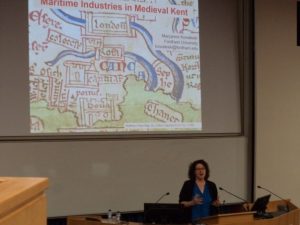
Maryanne Kowaleski assesses the significance of fishing.
After lunch we moved to ‘trade and industry’, the first lecture given by Professor Maryanne Kowaleski from Fordham University in New York. She explored maritime industries, focusing her talk on fishing and then waterfront construction and maintenance. Regarding fishing, she took her audience through the diversity of activities involving fishing, from the fish weirs and oyster fisheries of the Kentish north coast to the predominantly net and line fishing of the east and southern ports. She stressed the importance of seasonality within the industry, the frequency of fishermen-farmers and the share system employed for sharing the catch whereby a wide range of individuals could be involved, which was also one of the ways of sharing risk. Looking at her second case study, she noted the value ports placed on expertise from abroad regarding harbour maintenance and that in some ways the systems put in place at late medieval Hythe and Dover were reasonably successful given the relentless issue of deposition as a consequence of longshore drift.
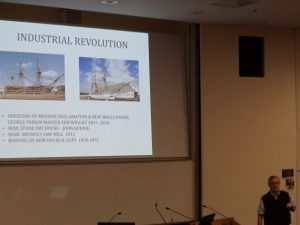
From wooden to iron ships – Martin Watts considers the implications for the workforce.
Maryanne was followed by Dr Martin Watts (CCCU), who summarised the main points Richard Holdsworth had made on Friday for the benefit of those who had missed that lecture, before exploring the industrialization of defence in Kent through the dockyards at Chatham and later St Mary’s Island. I’ll just pick out two pieces of information regarding the role of women in the dockyards that I found especially interesting. Firstly, that women were employed in the colour loft making the flags from the 18th century and these women were the wives and daughters of those killed in action. Secondly, that the mechanisation of the ropery led to the introduction of women workers in 1864, these women came from outside, so unlike those in the colour loft, and they did not receive the same level of respect as those in the colour loft and, not surprisingly given the times, were not paid as much as the men. Furthermore, to avoid fraternisation between the sexes, their hours of work were different to avoid entering or leaving the dockyard at the time as the men. After looking at Chatham, Martin then moved on to Richborough and the shipping revolution that took place there in the later years of the First World War.
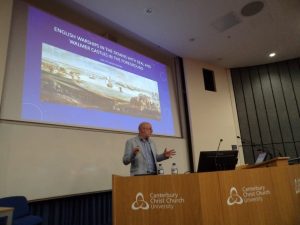
Chris Ware considers the siting of coastal defences.
The final session on ‘defending the coast’ began with Dr Christopher Ware’s (University of Greenwich) assessment of the role and importance of static defences from the time of Henry VIII, in other words from the time when artillery was a major factor. Hence coastal defences that were squat, such as Walmer Castle, rather than the lofty keep of medieval Dover Castle. Moreover, as well as being designed to give protection from invasion, these Tudor and later fortifications on the east coast were intended to protect ships anchored in The Downs, which had been a highly valued anchorage for centuries. Chris then turned his spotlight on the Thames and Medway estuaries, describing the different types of fortifications constructed on the southern (Kent) side, as well as providing ideas about just how expensive these were to maintain as viable parts of the nation’s defensive strategy.
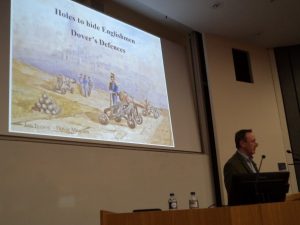
Jon Iveson investigates Dover’s defences against the threat from Napoleonic France.
Jon Iveson (Dover Museum), as the final speaker, took up this very important factor – cost; and whether contemporaries, and today’s historians consider this expense was justified and justifiable. Jon used Dover as his case study, looking at the later 18th and early 19th centuries when first revolutionary and then Napoleonic France looked especially dangerous, and at Dover’s Western Heights, the castle or Eastern Heights, and finally the beach in the Dour valley. To give you an idea of the figures he produced, between 1793 and 1816 £402,000 was spent on labour on the Dover defences, and, as he said, if you add in the bricks and other materials, you would need to more than double that figure to about a £1,000,000 in total. For this Dover got, amongst other fortifications, The Citadel, the Drop Redoubt, the Grand Shaft, Archcliffe Fort, Moats Bulwark, Guildford Battery and the Military Canal. Jon discussed the purpose of these fortifications – to stop Napoleon taking Dover from the landward side having landed on Romney Marsh and marched on Dover from there, a threat that was very real in 1803 when Napoleon stood on the French side of the English Channel surveying the possibility of invasion – and that he believes in these circumstances the sum spent can be seen as justifiable. As at the end of each session, these two lectures sparked a considerable number of questions and comments from audience members – always a good sign.
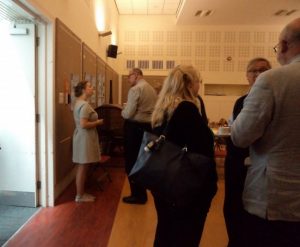
Mady explaining the finer points of the Fulton torpedo (model from Sandwich Guildhall Museum).
Finally, I just want to thank the following people for helping to make this a very successful conference. Stuart Bligh (Royal Museums Greenwich) and Dr Elizabeth Edwards (KAS) admirably chaired various sessions and are key members of this partnership on ‘Maritime Kent’, Mary-jane Pamphilon again took charge of Reception, ably assisted by Andrew Leach, and Dr Diane Heath my colleague was on hand too. Her husband Peter very generously transported the Sandwich Guildhall Museum’s model of a Fulton torpedo and exhibition boards to and from Canterbury, which meant John May and Mady Outen from the Sandwich Museum were able to display them at Old Sessions, creating considerable interest among the conference delegates – another excellent partnership the Centre can hopefully build upon for the future.
 Centre for Kent History and Heritage
Centre for Kent History and Heritage Sheila Sweetinburgh
Sheila Sweetinburgh 1135
1135